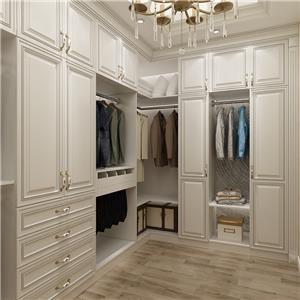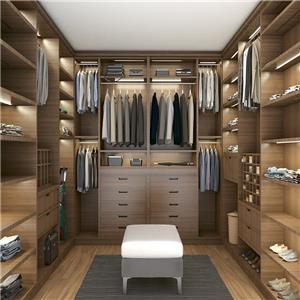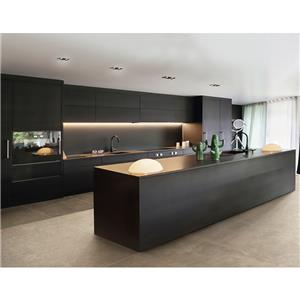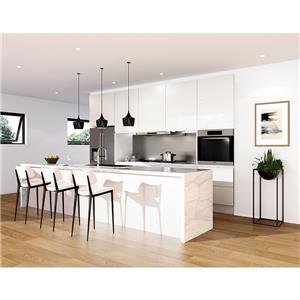Kitchen metal cabinets: the perfect collision of classic and modern
I. Introduction
The kitchen is known as the heart of the home. It is not only a place for cooking food, but also a center where family members gather and communicate emotionally. Its design directly affects the quality of daily life and happiness of the family. A kitchen with reasonable layout and complete functions can improve cooking efficiency and reduce the burden of housework. For example, good lighting and ventilation, and scientific storage system can make the space brighter and tidier. Integrating personalized elements into the design, such as the careful selection of colors and materials, not only reflects the taste of the residents, but also creates a warm and comfortable atmosphere and promotes intimate interaction among family members. In addition, the use of environmentally friendly and safe materials and focus on energy efficiency reflect care for the health of the family and the pursuit of a sustainable lifestyle. In short, kitchen design is the cornerstone of a happy family life, and it is about the perfect integration of practicality, beauty and emotion.
In the modern home trend that pursues both durability and design, metal cabinets are quietly returning and becoming a popular choice for kitchen decoration. They not only meet practical needs with their sturdy, durable and easy-to-clean properties, but also inject unique aesthetic elements into modern kitchen spaces through diverse metal textures, from the cold industrial style of stainless steel to the retro luxury of copper. It has achieved the perfect combination of function and fashion, leading a lifestyle change that integrates technology and art.
This article aims to delve into the innovative role of metal cabinets in modern kitchen design and analyze how they can redefine the functionality and style of kitchen spaces with their excellent durability, modern aesthetics and easy maintenance. By showing the diverse applications of metal materials, their integration with smart home technology, and their support for environmental protection concepts, it explains how metal cabinets can become a bridge connecting the past and the future, lead a new trend in kitchen design, and satisfy contemporary families’ demands for beauty, practicality, and Comprehensive needs for sustainability.
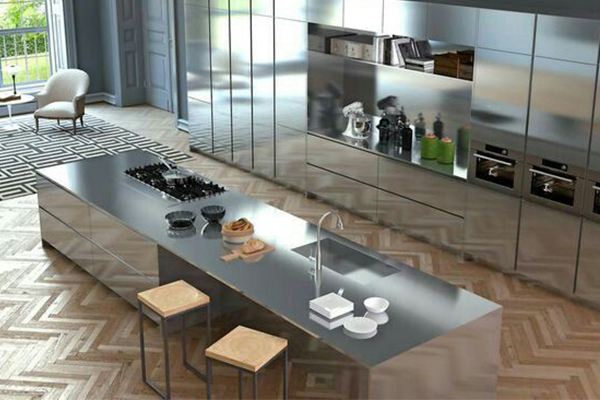
II. The historical evolution of metal cabinets
1.In the early 20th century, metal cabinets originated from the industrialization process and were mainly used in commercial kitchens in the early days. After World War II, with the booming metal manufacturing industry and the needs of housing construction, metal cabinets quickly became popular in American families. With their durability, ease of cleaning, and affordability, they have become a symbol of modern kitchens in many middle-class homes. These cabinets not only reflected the pursuit of practicality and efficiency in the post-war period, but also symbolized the changes brought about by technological advancement on home life, establishing the long-lasting role of metal in kitchen design.
2.Although metal cabinets were all the rage after World War II, they experienced a temporary decline as wood cabinets became more mainstream in the mid-to-late 20th century with their warm texture and customization flexibility. In recent decades, however, metal cabinets have enjoyed a significant renaissance, as design trends have cycled and an emphasis has been placed on sustainable materials.
The cultural factor behind the revival lies in the return of modern design aesthetics. People once again appreciate the minimalist lines and industrial style of metal as well as the sense of modernity and technology it conveys, which is in line with the contemporary trend of pursuing efficient and simple lifestyles. Economic factors involve the improvement of resource efficiency and environmental awareness. As a recyclable material, metal meets the requirements of the circular economy. Its durability reduces long-term costs and caters to consumers' dual considerations of cost performance and sustainability. In addition, scientific and technological progress has made metal surface treatment technologies more diversified, able to imitate different textures and meet individual needs, further promoting the popularity of metal cabinets.
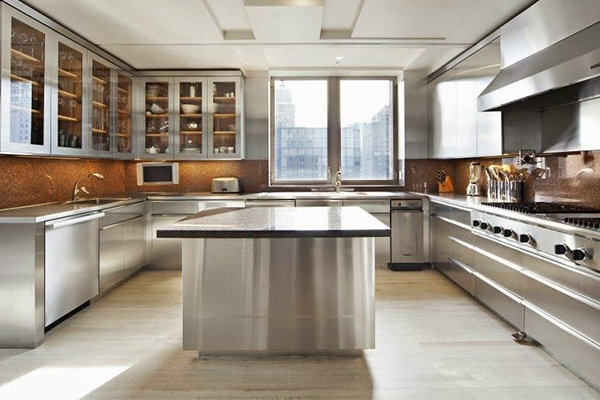
III. Types and materials of metal cabinets
1. Stainless steel cabinets
With its excellent corrosion resistance, metal cabinets can effectively resist kitchen moisture and oil smoke and extend their service life. The easy-to-clean feature makes daily care simple and fast, and it can be cleaned with just one wipe, keeping the kitchen space tidy and hygienic. In terms of design, the metal material perfectly matches the modern minimalist style. Its calm luster and linear design show a simple yet powerful aesthetic, providing a practical and fashionable living space for the fast-paced life.
2. Vintage metal cabinets
When it comes to the material selection of metal cabinets, non-traditional options such as copper and zinc alloy are gradually gaining popularity, bringing a retro charm and personalized trend to kitchen design. The unique patina formed by the natural oxidation of copper over time not only gives the cabinets a timeless beauty, but also perfectly integrates with retro or industrial-style interior design, showing a profound sense of history. Zinc alloy, with its changeable surface treatment effects, can simulate the texture of retro metal, from imitation bronze to distressed silver, to meet the personalized aesthetic needs of different consumers.
Cabinets made of these materials are not only beautiful, but also inherit the inherent durability and easy maintenance properties of metal, making them an ideal choice for homeowners who pursue a unique home style and are unwilling to compromise with the ordinary. Through customized design, each copper or zinc alloy cabinet can become a work of art in the kitchen, telling the story of the home, making the cooking space not only a functional area, but also a stage to display the taste and life philosophy of the residents.
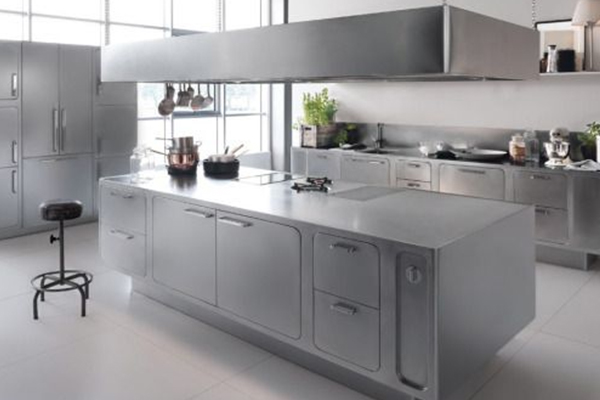
3. Colored metal panel
Powder coating technology brings a revolutionary surface treatment solution to metal cabinets. It adheres solid powder coating to the metal surface through electrostatic spraying, and forms a tough and uniform protective layer after high-temperature curing. This technology not only improves the weather resistance, wear resistance and corrosion resistance of the cabinets, but more importantly, the colorful selection of powder coatings can meet a wide range of aesthetic needs. From low-key matte black, elegant pearl white, to lively bright colors, and even wood grain and stone grain effects, powder coating technology allows metal cabinets to get rid of single colors and become a highlight in home decoration, adapting to various A variety of design styles, from modern simplicity to retro luxury, create unlimited possibilities for personalized kitchen space.
4. Lightweight metal frame and composite materials
In order to meet more diverse aesthetic and functional needs, metal cabinets are often cleverly combined with wooden or stone panels to create a unique visual and textural experience. The warm texture of the wooden panel is in sharp contrast with the coldness of the metal. It can not only retain the modern and simple lines, but also add a warm atmosphere to the home. It is suitable for kitchen spaces that pursue natural harmony. The combination of stone panels, such as marble or quartz stone, and metal frames shows the dual advantages of high-end luxury, durability and easy cleaning, and is suitable for kitchen environments that pursue both quality and practicality. This mix of materials not only enriches the design language, but also provides users with a wider range of choices, making the kitchen a living stage that showcases personality and taste.
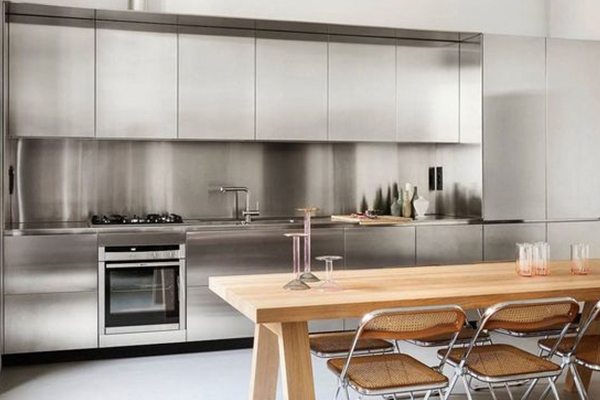
IV. Metal Cabinet Design Trends and Styles
1. Industrial style
The combination of metal cabinets, exposed brick walls and concrete floors forms a classic combination of industrial style design, showing a rough yet refined modern aesthetic. The cold and hard texture of the metal forms a strong contrast with the retro mottled brick walls and the simplicity of the concrete floor, creating a unique visual impact. This design not only strengthens the structure and layering of the space, but also cleverly blends historical and modern elements, making people feel the uncarved original charm and the simplicity and efficiency of modern life. In such a kitchen, every cooking session becomes an artistic experience that dialogues with the space, allowing every corner of the home to exude personality and stories.
2. Minimalism
Metal cabinets, with their simple and smooth lines, are ideal for creating a modern and refreshing kitchen space. Abandoning complicated decorations, the unique cool colors and sharp edges of metal materials can effectively expand the visual space and make the kitchen look more open and bright. This minimalist style not only reduces the visual burden, but is also easy to match with other furniture or decorative elements, creating an atmosphere of unpretentious elegance and practicality. In such a kitchen, every time you cook is a pleasure, it is simple yet stylish, and perfectly interprets the aesthetics of modern life.
3. Modern mix and match
The creative combination of metal cabinets and other materials, such as transparent or frosted glass door panels and warm wooden shelves, opens up endless possibilities for kitchen design, showing a high degree of personalization and modernity. The combination of the rigidity of metal and the transparency of glass not only enhances the visual extension of the space, but also enhances the aesthetics of storage display; while the metal frame paired with warm wooden elements injects a touch of natural warmth into the cold industrial style. Achieve the effect of combining hardness and softness. These mixed and matched designs not only enrich the level and texture of the kitchen, but also reflect the residents' unique pursuit of quality of life, making every detail exude a personalized artistic light.
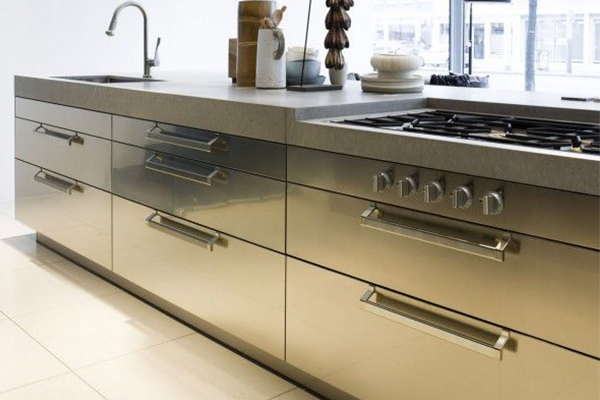
4. Future trend forecast
Modern kitchen design tends to be intelligently integrated, with cabinets embedded with high-tech elements such as sensor lighting and automatic lifting systems to enhance convenience and futuristic feel. The increasing awareness of environmental protection has prompted more brands to use environmentally friendly materials such as recyclable metals and low-VOC coatings to ensure aesthetics while protecting the living environment. Customized design has become a trend, and is tailored according to the user's living habits. Whether it is irregular space utilization or special functional requirements, it can be accurately met to achieve the unity of efficiency and personalization in the kitchen. These three major trends together create a modern kitchen space that is both smart and sustainable, making life more beautiful and convenient.
V. Purchasing and Installation Guide
1. Measurement and Planning
Accurate measurement is the basis for creating an ideal kitchen space. Every inch of the kitchen space needs to be carefully measured, including the location of doors and windows, and the layout of water and electricity pipes, to ensure that the cabinet design is accurate. At the same time, we have a deep understanding of family cooking habits and storage needs, and rationally plans the work triangle (refrigerator, sink, stove) to improve operating efficiency. Consider island tables and peninsula designs to increase meal preparation and interaction space. The integration of functional accessories such as corner baskets and lifting wall cabinets improves space utilization. Precise measurements and thoughtful layout planning combine to create a kitchen environment that is both beautiful and functional.
2. Cost considerations
Stainless steel cabinets have excellent corrosion resistance and almost no maintenance costs. Although the initial investment is higher in the long run, they have a long service life and are not easily damaged, which reduces replacement costs and is a cost-effective choice. In comparison, although materials such as copper or zinc alloy can provide unique aesthetic effects, they may oxidize over time and require regular maintenance, which slightly increases maintenance costs. Generally speaking, metal cabinets, especially stainless steel types, have shown significant cost-effectiveness from a long-term investment perspective due to their long-lasting durability and low maintenance characteristics. They not only enhance the practical value of the kitchen, but also add value to the home environment. invest.
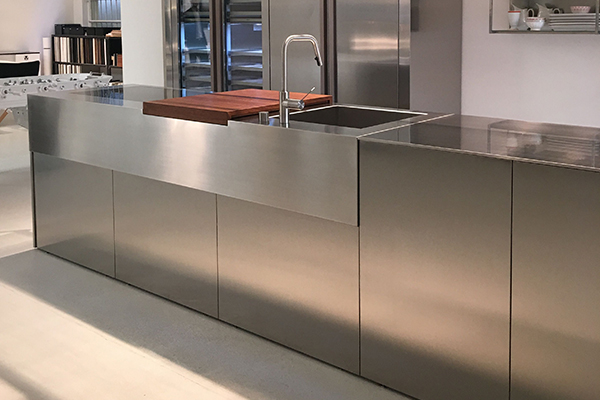
3. Installation and maintenance
Professional installation is key to ensuring your metal cabinets are stable, safe, and functional at their best. The professional team can accurately measure and precisely cut to ensure seamless connection and avoid problems such as looseness and leakage during subsequent use. As for daily maintenance, keep your cabinets dry, wipe them down regularly with a mild detergent, and avoid using sharp objects to scratch the surface. For specific metal materials, such as stainless steel, special cleaners can be used to remove fingerprints; copper cabinets can be wiped with lemon and salt to restore their luster. Proper maintenance can keep metal cabinets looking new over time, maintaining their beauty and functionality for a long time.
VI. Case study
1.In modern homes, metal cabinets have become the highlight of kitchen design with their unique charm. One example is a Nordic-style small apartment, which uses white high-gloss stainless steel cabinets to form a fresh contrast with the light wood floor. It not only visually expands the space, but is also easy to maintain, showing a minimalist yet warm attitude towards life. Another case is an industrial-style duplex apartment. Black iron cabinets are paired with exposed red brick walls and cement floors to create a rough yet high-end atmosphere. The cold hardness of metal and the warm lighting system are balanced to create a unique dining environment. There are also Mediterranean-style villas that use brushed copper panel cabinets, which naturally oxidize over time to form unique textures that complement the ocean blue tiles and stone countertops, conveying the quiet aesthetics of life over time. These cases demonstrate the wide application of metal cabinets in kitchens of different styles, which not only enhances the texture of the space, but also fully meets the dual needs of practicality and beauty.
2.In the design of small apartment kitchens, customized mirrored stainless steel cabinets have become a model of efficient use of space. The mirror reflection effect visually expands the space. At the same time, the intelligent storage system built into the cabinet maximizes storage, making the limited area full of functions, showing a simple yet functional modern life philosophy.
In an open kitchen design, metal and glass cabinets become a visual extension. The light metal frame paired with transparent glass door panels blurs the boundaries between the kitchen and other living areas. It not only introduces natural light, but also creates a transparent and spacious visual experience, perfectly integrating cooking and social functions.
For high-end residences, metal cabinets use luxurious materials and fine craftsmanship to demonstrate extraordinary taste. Brass or high-grade stainless steel is paired with precious stone countertops, supplemented by fine carving or inlay craftsmanship. Every detail highlights the nobility and uniqueness, creating a modern yet warm cooking space that becomes the artistic focus of the home and reflects the occupants’ view of life. The ultimate pursuit of quality.

VII. Conclusion
Metal cabinets, with their durability and ease of cleaning, bring long-term practical value and low maintenance costs to modern kitchens. In terms of design, the diversity of metal materials, such as the modern simplicity of stainless steel and the retro luxury of copper, not only enriches the aesthetic language of the kitchen, but can also be perfectly integrated with a variety of design styles, from industrial style to high-end luxury, to meet individual needs . Coupled with the integration of smart technology and environmental protection concepts, metal cabinets have become an iconic element that improves the quality of kitchen space and shows the residents' life attitude and aesthetic taste, adding unique charm and value to modern home life.
Today, when personalized design is prevalent and sustainable development has become a global consensus, metal cabinets, with their material diversity and design flexibility, have become the first choice to realize the unique style and environmental protection vision of the kitchen space. Whether you are pursuing minimalist modernity, retro luxury, or industrial style, metal materials can be perfectly matched through customized designs to show the unique taste of the residents. At the same time, the recyclability and durability of metal conform to the trend of green homes and contribute to future life. We encourage every reader to bravely explore and integrate the infinite creativity of metal cabinets into their personal living spaces, and jointly witness that the kitchen is not only a place for cooking, but also a stage where art and environmental protection concepts complement each other.

FAQs:
1. How to clean metal handles on kitchen cabinets?
To clean metal handles on kitchen cabinets, you can use a simple yet effective method: Apply some toothpaste onto a dry cloth and gently rub away stains on the metal surfaces. For more thorough cleaning, mix water with vinegar and wipe the handles, or soak them in a solution of diluted bleach for stubborn grease. Dry with a soft cloth afterward. This ensures a sparkling finish without damaging the metal.
2. How to paint metal kitchen cabinets?
Painting metal kitchen cabinets involves several steps to ensure a smooth and lasting finish. First, remove all hardware and thoroughly clean the cabinets with a degreaser to eliminate dirt and oil. Sand the surfaces with fine-grit sandpaper to roughen up the existing finish and promote adhesion. Next, apply a primer specifically designed for metal surfaces; this acts as a base layer and prevents rust. Once the primer is dry, lightly sand again and then apply your chosen paint using a foam roller for a uniform finish. Opt for a high-quality enamel or latex paint that's durable and suitable for kitchens. Apply at least two coats, allowing each coat to dry completely before recoating. Finally, reinstall the hardware and enjoy your newly refreshed cabinets.
3. Are metal kitchen cabinets good?
Metal kitchen cabinets offer numerous advantages, making them a highly desirable option. They are incredibly durable and resistant to moisture, humidity, and wear, ensuring longevity. Their strength supports heavy countertops and appliances without warping or cracking. Metal cabinets also provide a modern, sleek aesthetic, fitting various design styles from industrial to minimalist. They are easy to clean and maintain, often requiring just a wipe down, and some are coated with antibacterial finishes, promoting hygiene. Additionally, metal is recyclable, contributing to sustainable living. However, they may lack the warmth of wood and can be prone to dents or scratches. Overall, if durability, low maintenance, and contemporary design are priorities, metal kitchen cabinets are an excellent choice.

